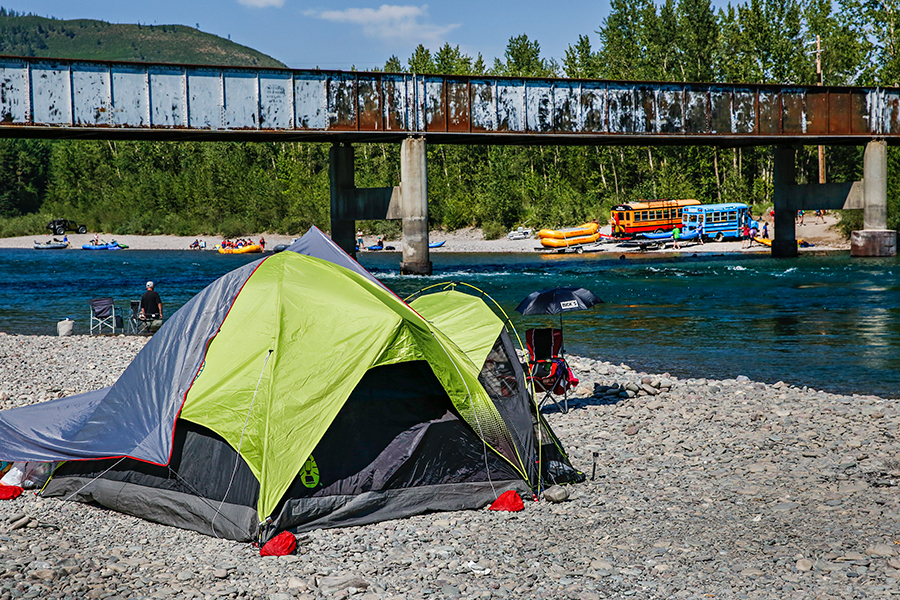A small gravel bar near the confluence of the North Fork and Middle Fork of the Flathead River by Blankenship Bridge has been a popular spot for boondocking since it was designated as a dispersed camping location more than a decade ago.
In recent months, amidst the coronavirus pandemic, and due in part to limited summer access to Glacier National Park, its popularity has exploded.
“It’s like Daytona Beach over spring break,” said Rob Davies, the Hungry Horse district ranger for the Flathead National Forest. “This year is off the charts in terms of use and visitation at that gravel bar.”
The gravel bar on the southwest bank of the river has a poor access road that has purposefully never been improved to make it a little challenging to get to, but that hasn’t stopped cars and campers from turning it into a lineless parking lot.
Davies has received many concerned phone calls from locals claiming the area is a disaster zone, which he characterizes as an exaggeration.
“It’s appalling, no doubt about it,” Davies said. “But I wasn’t quite as appalled as I expected it be.”
On a recent visit, Davies said he noted at least 35 parties crammed onto the gravel bar — at least three times the usual number. After speaking to many groups, he determined at least 90 percent of the visitors were from out of state, and thought they were in “paradise.”
“Their perspective is a little different from someone who’s seen Blankenship Bridge before,” Davies said. “They don’t know anything about Wild and Scenic Rivers, they don’t know a whole lot about stewardship of the land, they’re totally happy.”
Even so, camping at the gravel bar is legal, and Davies said that overall compliance with rules has been pretty high. The main violations he observed were the building of stone fire rings and a lack of human waste containment.
Along the Middle Fork of the Flathead River, which is designated as a Wild and Scenic River, fires are only allowed on a metal fire pan or fire blanket, and solid human waste must be packed out.
There is a county maintained toilet across Blankenship Road and another toilet across the bridge that campers can use. While Davies said he saw several campers walking over to use them, he said it’s far from adequate for the number of people.
To address his concerns over waste containment, Davies ordered two porta-potties for the site, which arrived on Aug. 4, a clear eyesore on a designated scenic river.
“We’re basically throwing our hands up at this point,” Davies said.
Blankenship Bridge isn’t the only area in the Hungry Horse Ranger District with increased usage. Davies described a five-mile “bubble” around the park where visitors realize the limited access and closures and find the next closest site.
“Every pullout is full, we have people camping where we’ve never seen camping,” Davies said. “I saw tents practically on the pavement.”
Law enforcement for the district currently lacks the manpower needed to patrol every campsite and track extended usage, according to Davies. Instead, they’ve had to triage and deal with critical issues first.
Long term, the Blankenship Bridge site is one of many areas the Forest Service is looking to address with a new river management plan.
Public meetings were held last year to receive input on how some popular sites should be managed, but the planning has been on a hiatus due to the current pandemic.
Davies said that by late summer or early fall the Forest Service will have a newly drafted river plan and environmental assessment out for public review. He has been strongly urging any disgruntled citizens that call him to take part in the process.
Among the ideas being considered for the Blankenship Bridge site are making camping available via walk-in only, designating it exclusively for day use and adding a boat launch and vault toilets.
“It is a Wild and Scenic River though, so we have to be careful about the amount of development,” Davies said. “We have to maintain the values.”
Until the management plan is revised, Davies hopes the addition of the portable toilets and increased patrolling by law enforcement will get them through the summer without having to enact an emergency closure of the area.
“This could just be the wave of the future,” he said. But, “I feel COVID put people on this lockdown mode in the spring and when weather got nice, everyone decided Montana was the place to come.”
